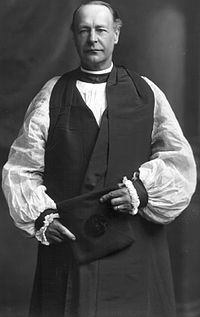Ernest Roland Wilberforce
|
The Rt Revd Ernest Wilberforce DD MA(Oxon) BD BA (Hons) |
|
|---|---|
| Bishop of Chichester | |

Wilberforce in episcopal robes
|
|
| Church | Church of England |
| Diocese | Diocese of Chichester |
| Installed | 1896 |
| Term ended | 1907 |
| Predecessor | Richard Durnford |
| Successor | Charles Ridgeway |
| Other posts | Bishop of Newcastle (1882–1896) |
| Orders | |
| Ordination | 1864 |
| Consecration | 1882 |
| Personal details | |
| Born |
22 January 1840 Brighstone, Isle of Wight |
| Died | 9 September 1907 (aged 67) Bembridge, Isle of Wight |
| Buried | West Hampnett, Chichester |
| Nationality | British |
| Denomination | Anglican |
| Parents | Samuel Wilberforce & Emily Sargent |
| Spouse | Frances Anderson (1863–70) Emily Connor (1874–1907) |
| Children | 3 sons & 3 daughters (with Emily) |
| Alma mater | Exeter College, Oxford |
Ernest Roland Wilberforce (22 January 1840 – 9 September 1907) was an Anglican clergyman and bishop. From 1882 to 1896 he was the first Anglican Bishop of Newcastle upon the diocese's creation, and from 1896 to 1907 he was Bishop of Chichester.
The third son of another bishop, Samuel Wilberforce, and his wife, Emily Sargent (1807–1841) — as well as the grandson of William Wilberforce, leader of the movement to abolish the slave trade — Ernest was born at his father's rectory, and grew up in Lavington and Cuddesdon, there gaining a love of country sports which lasted his whole life. Ernest's younger brother Basil became Archdeacon of Westminster. He was educated at Harrow from 1854 to 1857, then for 2 years with a private tutor, then from May 1859 to 1882 at Exeter College, Oxford. He showed little academic merit at any of these and – better known as a good oarsman than a good scholar – graduated BA in 1864 with fourth-class honours. During his time at Oxford he married Frances Mary, third daughter of Sir Charles Anderson, baronet (1804–1891) on 23 June 1863, and subsequently his attitude to his work and life became more serious, proceeding MA in 1867 and going to train for the ministry at Cuddesdon College, then under Edward King.
His father ordained him deacon in December 1864 and priest in 1865 and, after short curacies at Cuddesdon itself and at Lea, was presented to a living at Middleton Stoney, near Bicester, in 1868, though he had to resign from it two years later due to Frances' poor health (she died in October 1870 in San Remo of tuberculosis). In 1870 he became his father's domestic chaplain at Winchester, a year later sub-almoner to Queen Victoria, and in 1873 priest of Seaforth. This parish was traditionally evangelical and Ernest's moderate-high churchmanship could have led to friction with his parishioners, but his introduction of a daily service and a weekly celebration of holy communion was tactful and such conflict was avoided, and it was in this parish that Ernest first became known for the power of his sermons and his voice. Also in Seaforth, he and his new wife (on 14 October 1874 Ernest had married a second time, to Emily, only daughter of George Henry Connor, later dean of Windsor — the couple had 3 sons and 3 daughters) became active supporters of the temperance movement, taking the pledge together in 1876.
...
Wikipedia
